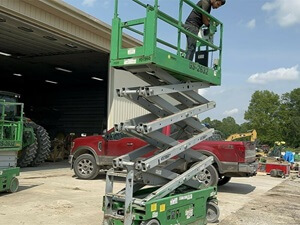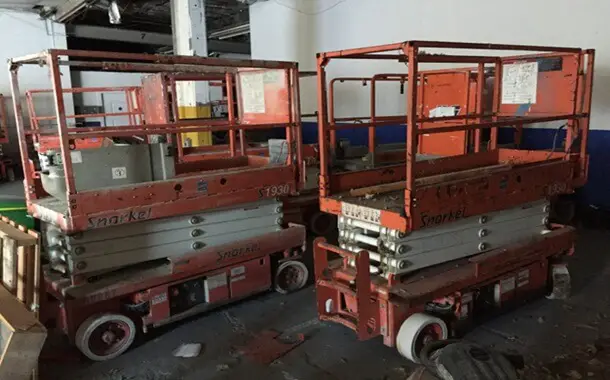How Much Does a Scissor Lift Cost?
Last Updated on December 14, 2023
Written by CPA Alec Pow | Content Reviewed by ![]() CFA Alexander Popinker
CFA Alexander Popinker
A scissor lift is a piece of equipment used in construction to lift workers and materials up high. It gets its name from the crisscross supports that raise and lower the platform. Scissor lifts utilize a hydraulic system that smoothly elevates the platform up to heights of 50 feet. Workers stand on the platform to safely access the upper floors and facades of buildings.
How Much Does a Scissor Lift Cost?
Many factors determine scissor lift pricing. New scissors cost between approximately $15,000 and $50,000. Used lifts cost considerably less at around $5,000 to $30,000 depending on age, brand, and capabilities.
Standard New Scissor Lift Prices
The base price for a new diesel or electric scissor lift starts around $15,000 and climbs steeply from there. On average, expect to spend:
- $15,000 – $25,000 for a small 12 – 22 ft. lift
- $25,000 – $35,000 for a medium 26 – 32 ft. lift
- $35,000 – $50,000+ for a large 36 – 50 ft. lift
Keep in mind that larger platforms, higher lifting heights, all-terrain mobility, and increased load capacities all boost costs. Additional accessories can add thousands more.
Used Scissor Lift Pricing
Thankfully, used scissor lifts sell for significantly less, making them economical alternatives:
- $5,000 – $15,000 for late model, low-hour units
- $1,000 – $7,000 for early 2000’s era, high hour units
When considering pricing on used lifts, carefully balance hours of use, age, and maintenance affect total cost.
Green Building Elements notes that a new scissor lift with a 19′ reach costs anywhere between $12,000 and $14,000. A used 19’ scissor lift costs between $3,500 and $6,000, and a used 30’ scissor lift can be purchased for anywhere between $7,500 and $15,000.
According to BigRentz, the scissor lift rental cost varies by the size of the scissor lift and the rental duration. According to them, common scissor lift rental rates are as follows:
- Daily: $100–$425
- Weekly: $250–$950
- Monthly: $475–$2,725
Tuhelift The cost of a scissor lift can vary based on its height. For example, a new scissor lift with a 3-4 meter (10-13 feet) height can cost between $4,000 and $5,000.
The Platforms and Ladders website provides pricing for various drivable scissor lifts, with prices ranging from $16,218 for a 10-foot lift to $69,702 for a 45-foot lift.
Additional Ownership Costs
The acquisition is the first financial step in a scissor lift ownership. Companies must also budget for:
Insurance – Protects owners if damage or injuries occur. Annual premiums range from $500 – $1500+. Getting quotes early usually gets you better rate estimates.
You might also like our articles about the cost of crane rental, scaffolding rental, or temporary fence rental.
Transportation – Scissor lifts require hauling via trailer or flatbed truck. These costs either come from equipment rental fees or by outsourcing delivery entirely.
Training – OSHA mandates all operators complete formal instruction before running lifts to ensure safety and prevent accidents. Courses cost $200+.
Maintenance & Inspections – Consistent service and assessments prevent malfunctions and keep lifts running optimally for years. Parts, fluids, and labor expenses add up over time.
How Do Scissor Lifts Work?
Scissor lifts utilize a crisscrossing lever system of metal supports to provide lifting power. The upward force needed to extend this scissor mechanism comes from pressurized hydraulic fluid.
An electric or diesel engine drives a hydraulic pump that feeds fluid to cylinders at the fulcrum point of each scissors pair. The cylinders expand, forcing the scissor arms to unfold upward, thus raising the platform.
Controls mounted on the platform give workers exact command over lift height and descent speed. Outriggers on the base stabilize the unit when fully extended.
What Features Do Scissor Lifts Have?
Scissor lifts offer an array of capabilities to improve safety and convenience:
Platform Enclosures – Guardrails and entry chains provide security for elevated workers. The platforms themselves resist damage, slippage, and penetration for durability.
Capacity Lights – Green and red signals clearly display safe load levels based on how many people and materials occupy the platform. Excess loads trigger audio alarms.
Descent Alarms – Loud buzzers activate during platform lowering to alert those below. This prevents workers from getting struck by the platform.
Drive Enable Bars – These bars must be held down for the drive motors to engage. This leaves operators in full control while preventing unintended movement.
Tilt & Motion Sensors – These automatically lock platform height if tipping or uneven terrain is detected. When conditions normalize, lifts resume operation.
AC Power Outlets – Onboard 120-240v power outlets run pneumatic tools, chargers, lighting, and more. Some models offer dual voltage capabilities.
Non-Marking Tires – White, foam-filled wheels prevent marring or scratching flooring during indoor use. Outdoor models use lug tread instead for traction.
Aircraft-Grade Aluminum – Crafted from lightweight alloys that resist weathering, scissor lifts themselves are durable investments built to endure years of heavy use.
What Safety Measures Apply to Scissor Lifts?
 Strict protocols exist to prevent scissor lift accidents:
Strict protocols exist to prevent scissor lift accidents:
Inspections – Workers must examine components like cables, tires, and fluid levels daily prior to operation for defects. Monthly in-depth assessments also occur.
Training – Only qualified personnel who have completed hands-on instruction can operate lifts. Refresher courses might also be periodically mandated.
Harnesses – Workers must wear fall protection connected to established anchor points while aloft. Harnesses prevent plummeting if loss of balance occurs.
Equipment Checks – Lifts cannot exceed rated load capacities shown on data plates. Workers must also avoid modifying or disabling safety measures.
Spotters – Ground guides assist movable lifts ensuring clear pathways to prevent collision with objects. Spotters also warn nearby pedestrians of approaching lifts.
What Affects New Scissor Lift Pricing?
Size – The larger the platform, the higher the cost. Compact lifts only accommodate 1-2 workers versus teams that huge decks fit.
Height – Lifts that reach towering heights up to 105 feet are more expensive than standard 50-foot models. Working weight capacity increases require more materials.
Capacity – Heavy-duty lifts built to handle greater loads using beefier components have much higher price tags. Light-medium duty lifts support 500-750 pounds while ultra-capacity lifts handle 3000+ lbs.
Fuel Source – Diesel lifts utilize more costly engines driving up expenses, whereas electric scissors rely on battery packs. However, diesels pack more lifting power.
Terrain – All-terrain and rough terrain scissor lifts feature heavy-duty construction including chassis reinforcements and suspension systems not found on slab lifts. These specializations raise costs substantially.
Options – Additional accessories like panel carriers, welding leads, aircraft tie-downs, and tool trays can cost more. Custom colors and graphics also bump up pricing.
Brand Name – Leading manufacturers like JLG, Genie, and Skyjack build exceptional lifts that perform incredibly well in rigorous rental fleets. These trusted brands cost more than generic competitors.
What Affects Used Scissor Lift Pricing?
When purchasing used equipment, factors like age, hours of use, and overall condition heavily influence pricing:
Age – Newer lifts less than 5 years old cost much more than dated 10-15-year-old models with obsolete designs. Electronics and controls evolve so newer units seem advanced versus old.
Hours – Low-hour units less than 2000 hours suggest limited use. High hour lifts over 4000 hours indicate extensive wear-and-tear that requires maintenance and parts replacement soon. Shop records detailing regular servicing are ideal.
Condition – Major collision damage, oil leaks, frayed wires, and extreme cosmetic wear are red flags. However minor scuffs and scratches are expected on used equipment. Verify so that no critical safety aspects or load handling elements are compromised.
Location – Certain areas of the country like the Rust Belt see faster deterioration of metal components than arid Southwest regions. Cold weather also quickens wear by embrittling components after repeated exposure.
Maintenance History – Consistent servicing and part replacement guarantees optimum performance and longevity. Units that don’t have records likely weren’t cared for properly.
Why Choose Scissor Lift Financing?
Paying $25,000 or more upfront for a new scissor lift hits budgets for smaller contractors. This prevents people from an asset that can immediately begin generating revenue.
Financing spreads payments out over months or years until the lift is completely paid off. This frees up capital for additional purchases like tools or skilled labor that quicken growth.
Additional benefits of scissor lift financing include:
Preserving Credit – Loans don’t tie up business lines of credit as credit cards do. This maintains borrowing power for future opportunities or emergencies.
Tax Advantages – Properly structured equipment loans may qualify for tax deductions of interest paid. This can result in thousands saved annually.
No Down Payment – Many lenders offer 0% down financing deals on new equipment allowing faster payoff once rented out.
Flexible Terms – Loans range from short 12-month terms up to 7-year periods for larger purchases. This allows matching costs to the project length.
Conserving Cash Flow – Stretching financing out longer keeps monthly payments lower. This prevents restricted cash flow that hurts daily operations.
Simplified Processing – Online applications make acquiring funding easier than traditional bank loans requiring extensive documentation. Approvals happen within hours or days.
Ways to Save on Scissor Lifts
Follow these tips to keep lift expenses in check:
Buy Used – Gently used models offer substantial savings over new (generally 40%+ off retail). Expand search distance to source better deals if needed.
Lease Short-Term – Seasonal leasing retains capital while securing vital equipment only during peak periods when profits justify costs.
Share Lifts – Arrange lift sharing with other local contractors during overlapping projects. This cuts the ownership quantities each company requires.
Use Rental Income to Offset – Generate rental revenue when you rent a scissor lift on equipment sharing apps if not needed. Additional utilization helps with holding costs.
Prevent Damage – Strictly enforce safety protocols and inspections to reduce accidents causing costly repairs. Institute thorough operator training programs.
Whether starting up or scaling your business to the next level, acquiring vital equipment like a scissor lift often requires financing to make the math work. Exploring funding early on can set operations in motion faster so you capture more market share right when the opportunity strikes. The profits generated will quickly offset purchase costs and propel your bottom line skyward!



Leave a Reply
Want to join the discussion?Feel free to contribute!